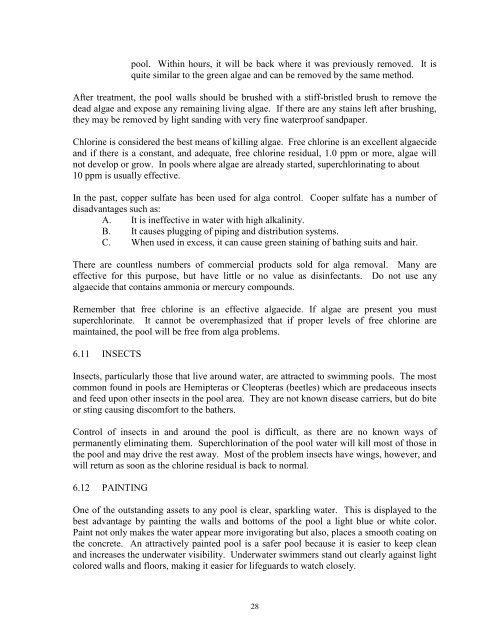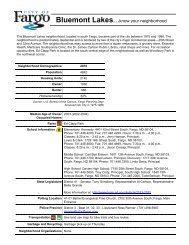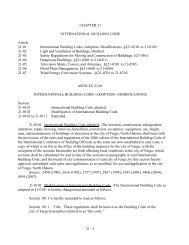Create successful ePaper yourself
Turn your PDF publications into a flip-book with our unique Google optimized e-Paper software.
pool. Within hours, it will be back where it was previously removed. It isquite similar to the green algae and can be removed by the same method.After treatment, the pool walls should be brushed with a stiff-bristled brush to remove thedead algae and expose any remaining living algae. If there are any stains left after brushing,they may be removed by light sanding with very fine waterpro<strong>of</strong> sandpaper.Chlorine is considered the best means <strong>of</strong> killing algae. Free chlorine is an excellent algaecideand if there is a constant, and adequate, free chlorine residual, 1.0 ppm or more, algae willnot develop or grow. In pools where algae are already started, superchlorinating to about10 ppm is usually effective.In the past, copper sulfate has been used for alga control. Cooper sulfate has a number <strong>of</strong>disadvantages such as:A. It is ineffective in water with high alkalinity.B. It causes plugging <strong>of</strong> piping and distribution systems.C. When used in excess, it can cause green staining <strong>of</strong> bathing suits and hair.There are countless numbers <strong>of</strong> commercial products sold for alga removal. Many areeffective for this purpose, but have little or no value as disinfectants. Do not use anyalgaecide that contains ammonia or mercury compounds.Remember that free chlorine is an effective algaecide. If algae are present you mustsuperchlorinate. It cannot be overemphasized that if proper levels <strong>of</strong> free chlorine aremaintained, the pool will be free from alga problems.6.11 INSECTSInsects, particularly those that live around water, are attracted to swimming pools. The mostcommon found in pools are Hemipteras or Cleopteras (beetles) which are predaceous insectsand feed upon other insects in the pool area. They are not known disease carriers, but do biteor sting causing discomfort to the bathers.Control <strong>of</strong> insects in and around the pool is difficult, as there are no known ways <strong>of</strong>permanently eliminating them. Superchlorination <strong>of</strong> the pool water will kill most <strong>of</strong> those inthe pool and may drive the rest away. Most <strong>of</strong> the problem insects have wings, however, andwill return as soon as the chlorine residual is back to normal.6.12 PAINTINGOne <strong>of</strong> the outstanding assets to any pool is clear, sparkling water. This is displayed to thebest advantage by painting the walls and bottoms <strong>of</strong> the pool a light blue or white color.Paint not only makes the water appear more invigorating but also, places a smooth coating onthe concrete. An attractively painted pool is a safer pool because it is easier to keep cleanand increases the underwater visibility. Underwater swimmers stand out clearly against lightcolored walls and floors, making it easier for lifeguards to watch closely.28












